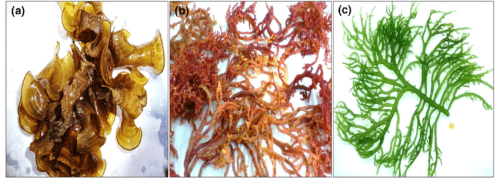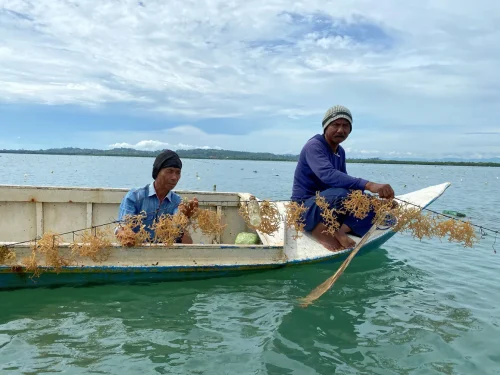Opportunities and Challenges of Seaweed as a Commodity

Photo Credit : Boedi Julianto
It is widely known that seaweed has significant economic value in various aspects. Seaweed is used in a variety of industries and has a wide array of economic benefits.
In the last 5 decades the increase in demand for seaweed from abroad such as China, Europe and America has become a driver of seaweed cultivation in Indonesia.
Seaweed has been known for centuries as food, medicine and fertilizer by coastal communities. As a macroalgae, seaweed grows in tidal area habitats, whether it grows naturally or is cultivated. Divided into 3 taxonomic groups namely Brown Seaweed (Phaeophyta), Red Lau Grass (Rhophyta) and Green Seaweed (Chlorophyta), seaweed has thousands of species.

(a) Phaeophyta (Brown Variant) (b) Rhodophyta (Red Variant) (c) Chlorophyta (Green Variant) (Photo Credit : Prakash Bhuyar)
The content of the main elements and substances contained in seaweed makes seaweed a commodity that competes between in the food, beverage, cosmetics, medicine, fertilizer, animal feed industries. Seaweed also has potential as a renewable energy source. Several studies have been conducted to convert seaweed into biofuel or biofuel. The process of producing biofuels from seaweed can create jobs and provide economic value in the renewable energy sector. Plays an important role in aquatic ecosystems that are useful as mitigation of eutrophication, carbon sequestration, and as a habitat for aquatic biota.
Seaweed is one of the leading commodities of aquaculture fisheries, in addition to shrimp, lobster, and crab. Types of seaweed that are widely cultivated include Eucheuma cotonii, Eucheuma spinosum, and Gracilaria verrucosa. In 2021, the export volume of seaweed was 225,612 tons with an export value of 222.6 million US dollars. The main export destination countries include China, Vietnam and South America.
Increasing the competitiveness of seaweed exports is recognized to still face challenges from competing producing countries, such as China and the Philippines. In addition, the seaweed product market also competes with other hydrocolloid products sourced from plants, animals and chemicals. Efforts to encourage exports are carried out by exporting raw materials that parallel value-added products such as carrageenan flour.
The cultivation of this plant is quite easy compared to the cultivation of other horticultural crops. Minimal maintenance, minimal cost and does not require special land. The results of a Zannie Langford study in 2022 reported that at least 250,000 households depend on this sector. Aquaculture is generally carried out in coastal waters and marine areas throughout Indonesia, especially in coastal areas that have suitable water conditions. Some areas known as the center of seaweed cultivation in Indonesia include East Kalimantan, West Nusa Tenggara (NTB), South Sulawesi, East Java and Maluku.

Seaweed Cultivation in South Sulawesi (Photo Credit : Asdar Marsuki)
In accordance with the Blue Economy Program carried out by the Minister of Marine Affairs and Fisheries of the Republic of Indonesia, there are four areas plotted into special conservation of grass cultivation as well as developed into seaweed industry clusters, namely in North Kalimantan, East Sumba, Southeast Sulawesi and in Maluku, Indonesia still has a land area that has the potential to cultivate seaweed of 12.8 million hectares which is expected to be a centralized place for grass cultivation The sea is protected and only for the development of seaweed cultivation.
Economic Value of Seaweed
Some factors considered to calculate the economic value of seaweed are production volume, market price, and added value of the product produced. The factors used in calculating the economic value of seaweed are: production volume, determining selling price, production value, added value. Currently, the production value of lau grass is seaweed as an industrial raw material. The added value of grass can be increased by processing it as a hydrocolloid, such as carrageenan, and agar-agar.
The economic value of seaweed can fluctuate depending on several market factors, such as demand and supply, as well as external factors such as policy changes or weather conditions.
From July 2021 to August 2022, the selling price of dry sea moss increased from IDR 19,500/kg to IDR 50,00/kg. However, from March 2023 to September 2023, seaweed farmers and seaweed business actors complained that the price of seaweed continued to decline from IDR 42,000 to gradually decrease to reach IDR 8,000/kg, one of the factors that caused this price drop due to conflicts in Europe and reduced demand for seaweed from the Chinese market. The water content of dried seaweed is one that must be considered by seaweed business actors. The desired moisture content according to market demand ranges from 35%-38%, while the maximum gross content is 35. Maintaining price stability is the main key. Seaweed business actors can anticipate price fluctuations by improving product quality.
The results of Seaweed Insight Analysis, in 2020 Indonesia is the second largest producer after China. In that period of the year, Indonesia's total harvest volume reached 9.5 million tons with an average annual growth rate of 9.3%.
Data from the Ministry of Maritime Affairs and BPS shows that Indonesia's seaweed production has increased by 9.12 million tons in 2021, and 232 tons in 2022. In 2021, Indonesia's seaweed export volume reached 180.6 thousand tons or valued at USD 455.7 million, an increase of 93% compared to the same period in 2022 The export value of seaweed reached USD 398 or equivalent to IDR 6.1 trillion (exchange rate of IDR 15,300/USD).
Opportunities as an economic commodity are certainly a big attraction for increasing the yield of cultivated or natural seaweed. Minimal maintenance and capital compared to aquaculture or horticultural crop farming is also an attraction for seaweed. In every opportunity there is always a challenge, the biggest challenge is export competitiveness, but maintaining quality, good management from seed selection, planting, care to harvest and ready to sell is the main important determining factor.
-YN

